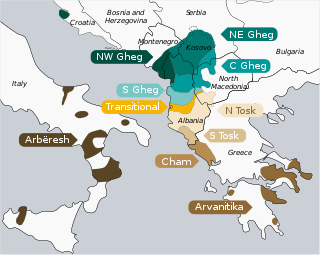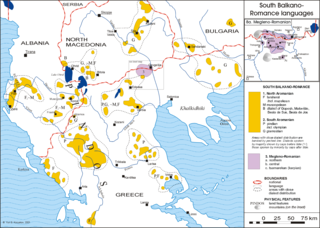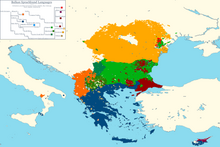
Bulgarian is an Eastern South Slavic language spoken in Southeast Europe, primarily in Bulgaria. It is the language of the Bulgarians.
Infinitive is a linguistics term for certain verb forms existing in many languages, most often used as non-finite verbs. As with many linguistic concepts, there is not a single definition applicable to all languages. The name is derived from Late Latin [modus] infinitivus, a derivative of infinitus meaning "unlimited".

Macedonian is an Eastern South Slavic language. It is part of the Indo-European language family, and is one of the Slavic languages, which are part of a larger Balto-Slavic branch. Spoken as a first language by around 1.6 million people, it serves as the official language of North Macedonia. Most speakers can be found in the country and its diaspora, with a smaller number of speakers throughout the transnational region of Macedonia. Macedonian is also a recognized minority language in parts of Albania, Bosnia and Herzegovina, Romania, and Serbia and it is spoken by emigrant communities predominantly in Australia, Canada and the United States.
A sprachbund, also known as a linguistic area, area of linguistic convergence, or diffusion area, is a group of languages that share areal features resulting from geographical proximity and language contact. The languages may be genetically unrelated, or only distantly related, but the sprachbund characteristics might give a false appearance of relatedness.

The proposed substratal elements in Romanian are mostly lexical items. The process of determining if a word is from the substratum involves comparison to Latin, languages with which Romanian came into contact, or determining if it is an internal construct. If there are no matching results, a comparison to Albanian vocabulary, Thracian remnants or Proto-Indo-European reconstructed words is made.
Aorist verb forms usually express perfective aspect and refer to past events, similar to a preterite. Ancient Greek grammar had the aorist form, and the grammars of other Indo-European languages and languages influenced by the Indo-European grammatical tradition, such as Middle Persian, Sanskrit, Armenian, the South Slavic languages, Georgian, Pontic Greek, and Pashto, also have forms referred to as aorist.
This is a list of languages spoken in regions ruled by Balkan countries. With the exception of several Turkic languages, all of them belong to the Indo-European family. A subset of these languages is notable for forming a well-studied sprachbund, a group of languages that have developed some striking structural similarities over time.

The South Slavic languages are one of three branches of the Slavic languages. There are approximately 30 million speakers, mainly in the Balkans. These are separated geographically from speakers of the other two Slavic branches by a belt of German, Hungarian and Romanian speakers.

Torlakian, or Torlak, is a group of transitional South Slavic dialects of southeastern Serbia, Kosovo, northeastern North Macedonia, and northwestern Bulgaria. Torlakian, together with Bulgarian and Macedonian, falls into the Balkan Slavic linguistic area, which is part of the broader Balkan sprachbund. According to UNESCO's list of endangered languages, Torlakian is vulnerable.
The conditional mood is a grammatical mood used in conditional sentences to express a proposition whose validity is dependent on some condition, possibly counterfactual.
Proto-Albanian is the ancestral reconstructed language of Albanian, before the Gheg–Tosk dialectal diversification. Albanoid and other Paleo-Balkan languages had their formative core in the Balkans after the Indo-European migrations in the region. Whether descendants or sister languages of what was called Illyrian by classical sources, Albanian and Messapic, on the basis of shared features and innovations, are grouped together in a common branch in the current phylogenetic classification of the Indo-European language family. The precursor of Albanian can be considered a completely formed independent IE language since at least the first millennium BCE, with the beginning of the early Proto-Albanian phase.
Languages of Yugoslavia are all languages spoken in former Yugoslavia. They are mainly Indo-European languages and dialects, namely dominant South Slavic varieties as well as Albanian, Aromanian, Bulgarian, Czech, German, Italian, Venetian, Balkan Romani, Romanian, Pannonian Rusyn, Slovak and Ukrainian languages. There are also pockets where varieties of non-Indo-European languages, such as those of Hungarian and Turkish, are spoken.
The grammar of Macedonian is, in many respects, similar to that of some other Balkan languages, especially Bulgarian. Macedonian exhibits a number of grammatical features that distinguish it from most other Slavic languages, such as the elimination of case declension, the development of a suffixed definite article, the lack of an infinitival verb, and the constructions with ima/nema formed with the auxiliary "to have", among others.

The official language of North Macedonia is Macedonian, while Albanian has co-official status. Macedonian is spoken by roughly two-thirds of the population natively, and as a second language by much of the rest of the population. Albanian is the largest minority language. There are a further five national minority languages: Turkish, Romani, Serbian, Bosnian, and Aromanian. The Macedonian Sign Language is the country's official sign language.

Albanian is an Indo-European language and the only surviving representative of the Albanoid branch, which belongs to the Paleo-Balkan group. Standard Albanian is the official language of Albania and Kosovo, and a co-official language in North Macedonia and Montenegro, as well as a recognized minority language of Italy, Croatia, Romania and Serbia. It is also spoken in Greece and by the Albanian diaspora, which is generally concentrated in the Americas, Europe and Oceania. Albanian is estimated to have as many as 7.5 million native speakers.

The Aromanian language, also known as Vlach or Macedo-Romanian, is an Eastern Romance language, similar to Megleno-Romanian, Istro-Romanian and Romanian, spoken in Southeastern Europe. Its speakers are called Aromanians or Vlachs.
Serbo-Croatian is a South Slavic language that, like most other Slavic languages, has an extensive system of inflection. This article describes exclusively the grammar of the Shtokavian dialect, which is a part of the South Slavic dialect continuum and the basis for the Bosnian, Croatian, Montenegrin, and Serbian standard variants of Serbo-Croatian. "An examination of all the major 'levels' of language shows that BCS is clearly a single language with a single grammatical system."
The Eastern South Slavic dialects form the eastern subgroup of the South Slavic languages. They are spoken mostly in Bulgaria and North Macedonia, and adjacent areas in the neighbouring countries. They form the so-called Balkan Slavic linguistic area, which encompasses the southeastern part of the dialect continuum of South Slavic.

Theodor Capidan was an Ottoman-born Romanian linguist. An ethnic Aromanian from the Macedonia region, he studied at Leipzig before teaching school at Thessaloniki. Following the creation of Greater Romania at the end of World War I, Capidan followed his friend Sextil Pușcariu to the Transylvanian capital Cluj, where he spent nearly two decades, the most productive part of his career. He then taught in Bucharest for a further ten years and was marginalized late in life under the nascent communist regime. Capidan's major contributions involve studies of the Aromanians and the Megleno-Romanians, as well as their respective languages. His research extended to reciprocal influences between Romanian and the surrounding Slavic languages, the Eastern Romance substratum and the Balkan sprachbund, as well as toponymy. He made a significant contribution to projects for a Romanian-language dictionary and atlas.

The Albanian–Eastern Romance linguistic parallels are subject of historical and contact linguistic research applied to the Albanian and Eastern Romance languages. It has also been studied to understand the history of Albanian and Eastern Romance speakers. The common phonological, morphological and syntactical features of the two language families have been studied for more than a century. Both are part of the Balkan sprachbund but there are certain elements shared only by Albanian and Eastern Romance languages that descended from Common Romanian. Aside from Latin, and from shared Greek, Slavic and Turkish elements, other characteristics and words are attributed to the Palaeo-Balkan linguistic base. Similarities between Eastern Romance and Albanian are not limited to their common Balkan features and the assumed common lexical items: the two language families share calques and proverbs, and display analogous phonetic changes, some of the latter especially shared between Tosk Albanian and Common Romanian.









